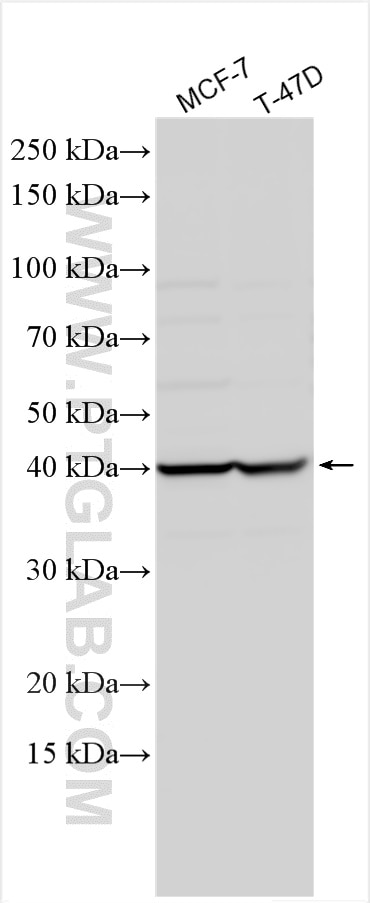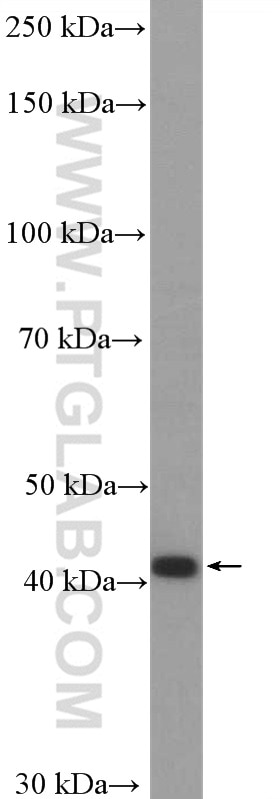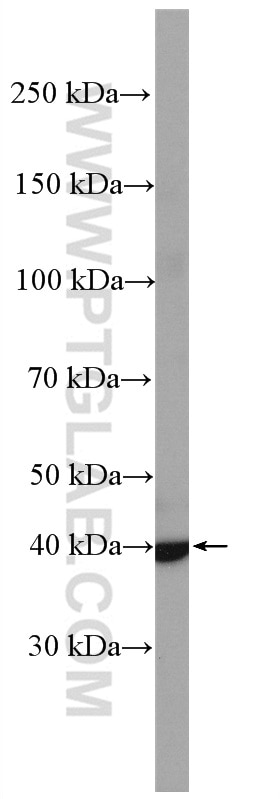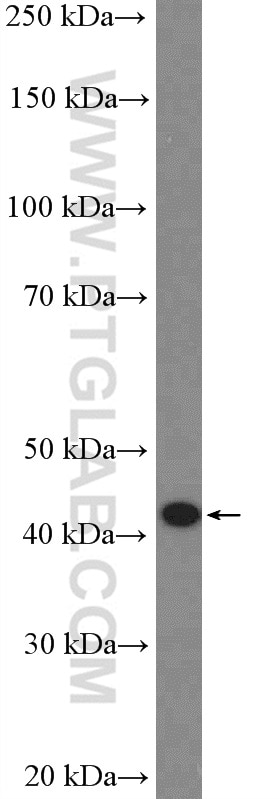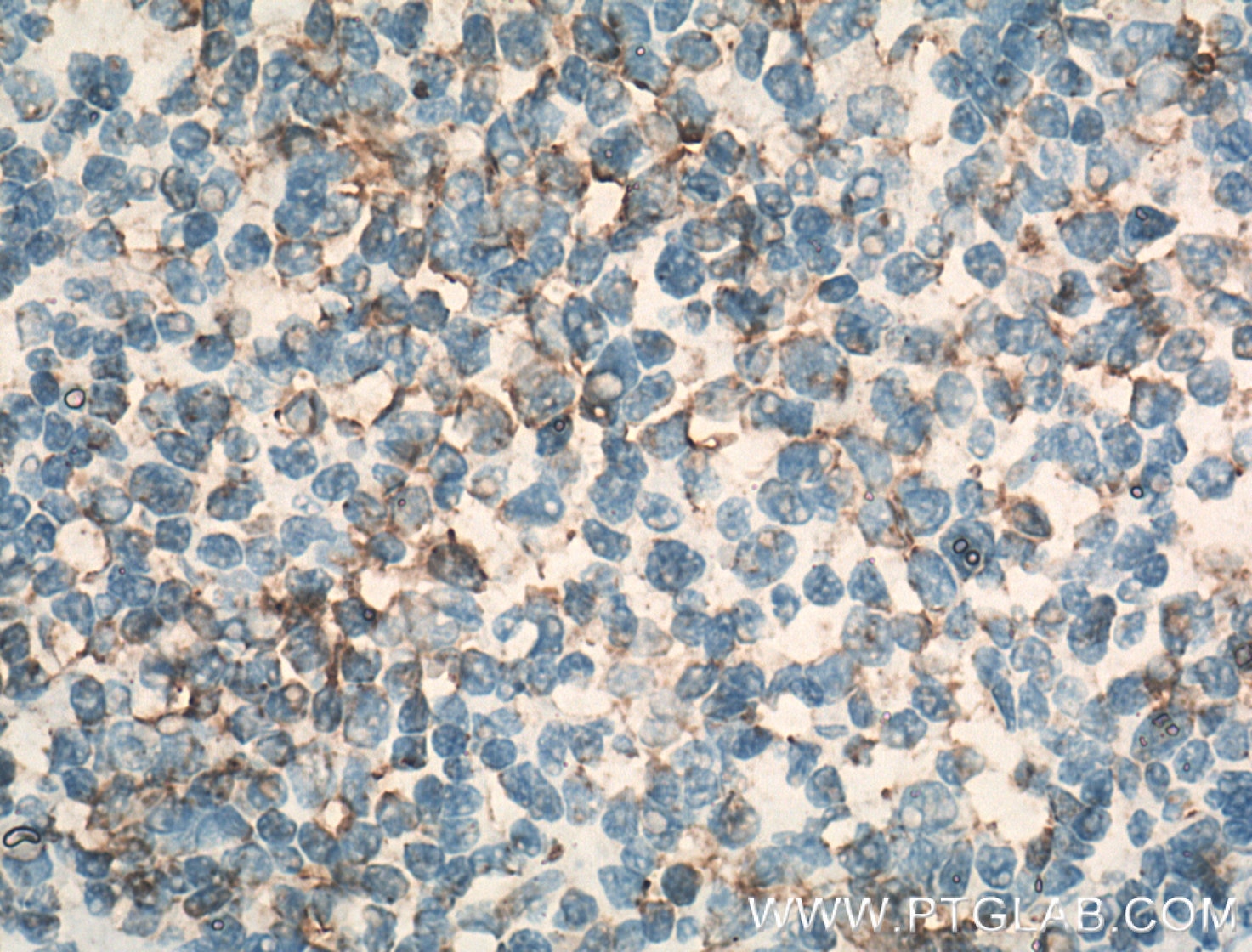CCR7 Polyklonaler Antikörper
CCR7 Polyklonal Antikörper für IHC, WB, ELISA
Wirt / Isotyp
Kaninchen / IgG
Getestete Reaktivität
human, Ratte und mehr (1)
Anwendung
WB, IHC, IF, ELISA
Konjugation
Unkonjugiert
Kat-Nr. : 25898-1-AP
Synonyme
Galerie der Validierungsdaten
Geprüfte Anwendungen
| Erfolgreiche Detektion in WB | MCF-7-Zellen, C6-Zellen, K-562-Zellen |
| Erfolgreiche Detektion in IHC | humanes Tonsillitisgewebe Hinweis: Antigendemaskierung mit TE-Puffer pH 9,0 empfohlen. (*) Wahlweise kann die Antigendemaskierung auch mit Citratpuffer pH 6,0 erfolgen. |
Empfohlene Verdünnung
| Anwendung | Verdünnung |
|---|---|
| Western Blot (WB) | WB : 1:500-1:1000 |
| Immunhistochemie (IHC) | IHC : 1:50-1:500 |
| It is recommended that this reagent should be titrated in each testing system to obtain optimal results. | |
| Sample-dependent, check data in validation data gallery | |
Veröffentlichte Anwendungen
| WB | See 4 publications below |
| IHC | See 6 publications below |
| IF | See 4 publications below |
Produktinformation
25898-1-AP bindet in WB, IHC, IF, ELISA CCR7 und zeigt Reaktivität mit human, Ratten
| Getestete Reaktivität | human, Ratte |
| In Publikationen genannte Reaktivität | human, Maus, Ratte |
| Wirt / Isotyp | Kaninchen / IgG |
| Klonalität | Polyklonal |
| Typ | Antikörper |
| Immunogen | CCR7 fusion protein Ag22941 |
| Vollständiger Name | chemokine (C-C motif) receptor 7 |
| Berechnetes Molekulargewicht | 378 aa, 43 kDa |
| Beobachtetes Molekulargewicht | 40-43 kDa |
| GenBank-Zugangsnummer | BC035343 |
| Gene symbol | CCR7 |
| Gene ID (NCBI) | 1236 |
| Konjugation | Unkonjugiert |
| Form | Liquid |
| Reinigungsmethode | Antigen-Affinitätsreinigung |
| Lagerungspuffer | PBS mit 0.02% Natriumazid und 50% Glycerin pH 7.3. |
| Lagerungsbedingungen | Bei -20°C lagern. Nach dem Versand ein Jahr lang stabil Aliquotieren ist bei -20oC Lagerung nicht notwendig. 20ul Größen enthalten 0,1% BSA. |
Hintergrundinformationen
C-C chemokine receptor type 7 (CCR7), which belongs to the G-protein coupled receptor 1 family, is also a receptor for the MIP-3-beta chemokine, and probably acts as a mediator of EBV effects on B-lymphocytes or of normal lymphocyte functions. CCR7 is specially expressed in various lymphoid tissues and activated B- and T-lymphocytes, and can be strongly up-regulated in B-cells infected with Epstein-Barr virus and T-cells infected with herpesvirus 6 or 7.
Protokolle
| Produktspezifische Protokolle | |
|---|---|
| WB protocol for CCR7 antibody 25898-1-AP | Protokoll herunterladen |
| IHC protocol for CCR7 antibody 25898-1-AP | Protokoll herunterladen |
| Standard-Protokolle | |
|---|---|
| Klicken Sie hier, um unsere Standardprotokolle anzuzeigen |
Publikationen
| Species | Application | Title |
|---|---|---|
Bioact Mater Two-stage degradation and novel functional endothelium characteristics of a 3-D printed bioresorbable scaffold. | ||
Virulence Intranasal bovine β-defensin-5 enhances antituberculosis immunity in a mouse model by a novel protein-based respiratory mucosal vaccine. | ||
Front Cell Dev Biol Potential Mechanisms of the Impact of Hepatocyte Growth Factor Gene-Modified Tendon Stem Cells on Tendon Healing. | ||
Stem Cell Res Ther Tendon stem cell-derived exosomes regulate inflammation and promote the high-quality healing of injured tendon. | ||
Front Mol Biosci CCR7 Has Potential to Be a Prognosis Marker for Cervical Squamous Cell Carcinoma and an Index for Tumor Microenvironment Change. | ||
Front Pharmacol MicroRNA-532-3p Suppresses Malignant Behaviors of Tongue Squamous Cell Carcinoma via Regulating CCR7. |
